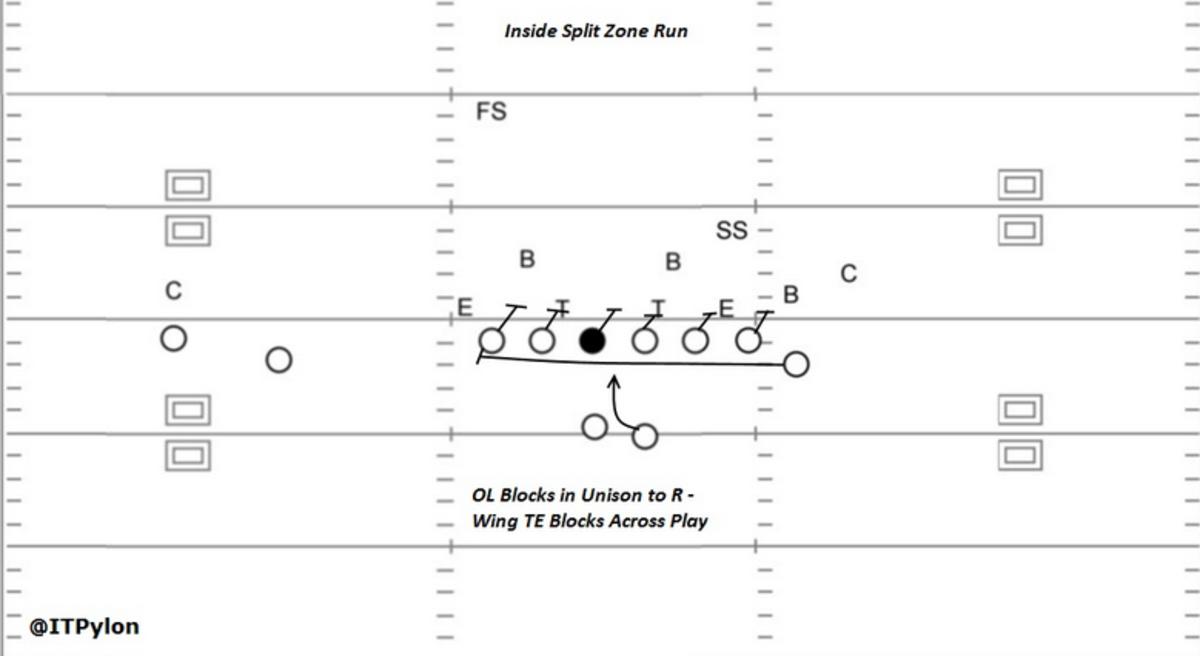Colts' Offensive Staples: Split Zone
The Indianapolis Colts under Frank Reich have consistently had one of the better offenses in the league, despite the team starting four (going on five) different quarterbacks over four years. In this new series, I hope to shed some light on why the Colts' offense has managed to stay efficient despite the turnover.
In the Colts' Offensive Staples series, I will be exploring some of Reich's favorite play calls for this offense. Obviously things change with new quarterbacks, but Reich has stayed pretty consistent on a few of his go-to calls over the years.
First up, we start with the ground game. The Colts have consistently produced strong running games with Reich at the helm, and that production obviously soared to new heights in 2021 behind Jonathan Taylor. One of the play calls that Taylor especially found a ton of success with was the split zone run.
Split zone is an inside zone run that has a slight variance from a typical zone play. In today's article, I dive into what this run play is, how the Colts use it, and what types of passing plays they build off of it.
What is a Split Zone Run?
Split zone is an inside zone rushing play that utilizes the tight end as a key backside blocker. This play is typically run out of 11 or 12 personnel, as the tight end is responsible for pulling across the formation to seal the backside defensive end/edge rusher. Here is how the Inside The Pylon Glossary defines the play:
The split zone is a variation of the zone run blocking scheme. In the zone blocking scheme players typically try to cut block the backside defensive end or edge defenders to prevent pursuit. In a split zone, the offensive player, typically a tight end or H-back, blocks across the flow of the play to handle the backside defender. The bulk of the offensive line blocks in one direction, and the split zone blocker comes across the flow to the opposite edge to seal the backside.
Here is play design of the call that ITPylon used in their article that I hyperlinked above:

Notice how the tight end/H-back/Sniffer Back (all terms for the same position) is pulling across the formation to seal off the backside end. The other linemen up front are down blocking like they would on a normal inside zone rush.
Colts' Split Zone
The Colts run split zone quite a bit and it has been a typical run call in their offense for years. Indy typically runs this out of 11 personnel, but I have seen times where they have done it out of 12 or 13 personnel as well.
Let's look through a couple examples of this call from this past season on film. Jack Doyle is the H-back responsible for pulling across the formation on this first split zone example (he's actually the H-back in every one of these examples).
At the snap of the ball, Doyle races across the formation and seals the edge defender with a low block. This creates enough space to the backside for Jonathan Taylor to plant his foot and get up field upon receiving the hand-off. The left tackle and left guard are also major positives on this play, as they get quick displacement with their initial zone blocks on the backside.
— Not Zach’s Burner (@NotZachsBurner1) June 6, 2022
Split zone is a quick timing play that relies on the tight end getting to their spot in a hurry. The tight end doesn't even have to make a perfect block, they just have to get enough of the backside edge rusher to slow down their pursuit.
That is exactly what Doyle does on this next play, as he just barely gets enough of the defensive end with his diving block. Ryan Kelly and Quenton Nelson also deserve major credit on this run, as they take care of the Mike Linebacker and one-tech defensive tackle with ease on the interior.
— Not Zach’s Burner (@NotZachsBurner1) June 6, 2022
Split zone is an efficient run play that can do wonders for a team with a dominant running back. With the Colts having a stout run blocking offensive line, and a top tier rusher in Jonathan Taylor, this play was money a year ago.
This last clip has Doyle again sealing the backside of the play as the rest of the offensive line washes out the defense at the point of attack. Taylor makes the slot corner miss in the hole, and then he is off to the races for a huge gain down the sideline.
— Not Zach’s Burner (@NotZachsBurner1) June 6, 2022
Building the Pass off of Split Zone
For a team that runs as much split zone as the Colts, it is easy to see what the logical pass play would be off of this call. Once teams begin to key on Doyle blocking when he comes across the formation, then the next step is to have him drift into the flats for a quick completion.
This touchdown pass against the Tennessee Titans last year is a perfect example. The backside defensive end is reading run all the way, and he actually makes his way past Doyle's would-be block on the outside.
However, this was a designed RPO call to have Doyle take advantage of the overeager defensive end. The edge rusher gets stuck in no man's land as Doyle drifts into the flat uncovered for the score.
— Not Zach’s Burner (@NotZachsBurner1) June 6, 2022
The Bottom Line
The Colts are a diverse rushing team that utilizes a touch of both power and zone in the run game. Their main staples, however, typically lean towards duo runs and inside zone. One of their favorite calls over the years has been this split zone call.
The biggest adjustment for 2022 will be how the team replaces Jack Doyle on these plays. He was absolutely vital to the success of this run over the years and his absence will surely be felt. Mo Alie-Cox and Jelani Woods should be adequate replacements, but they certainly need to prove that they can be on Doyle's level for this play to find continued success in the future.
Follow Zach on Twitter @ZachHicks2.
